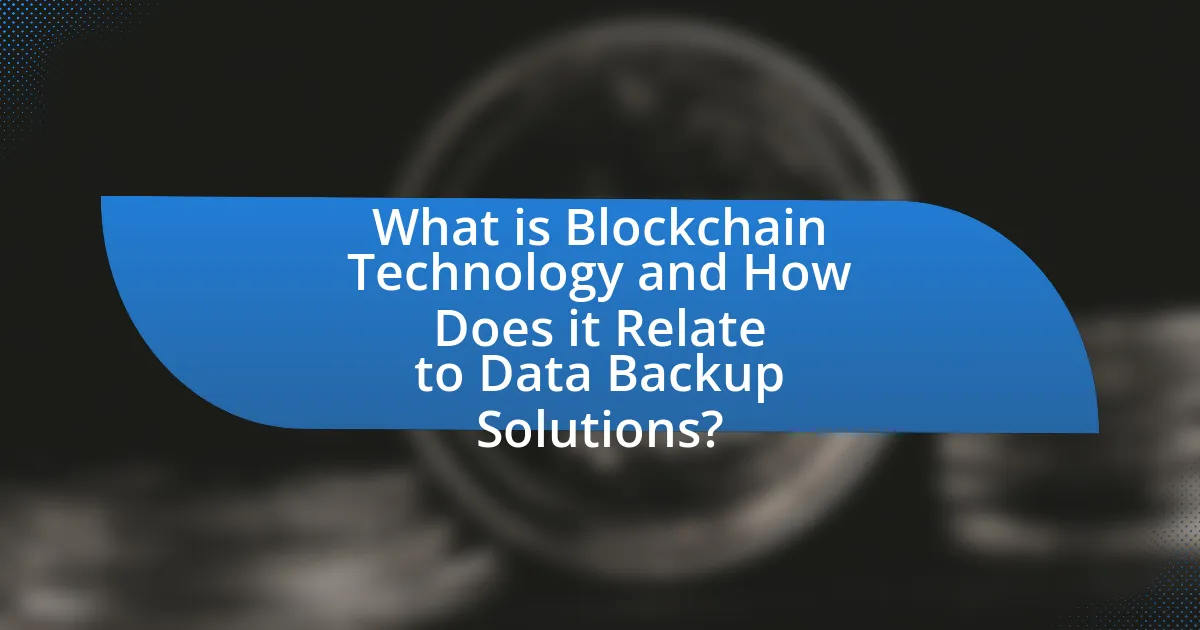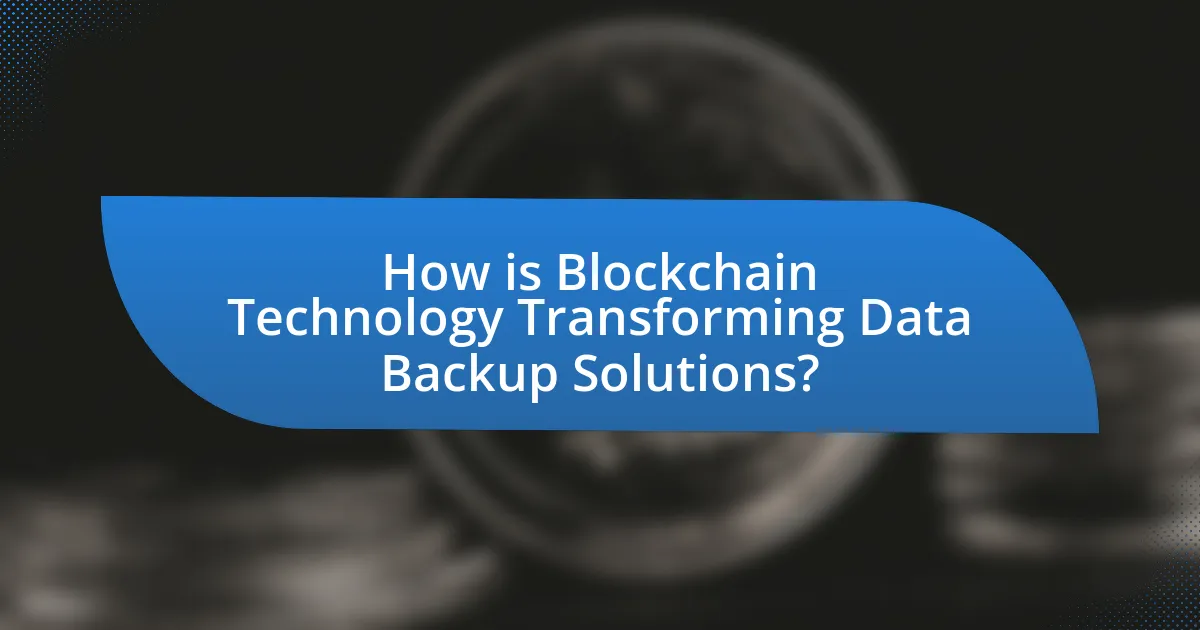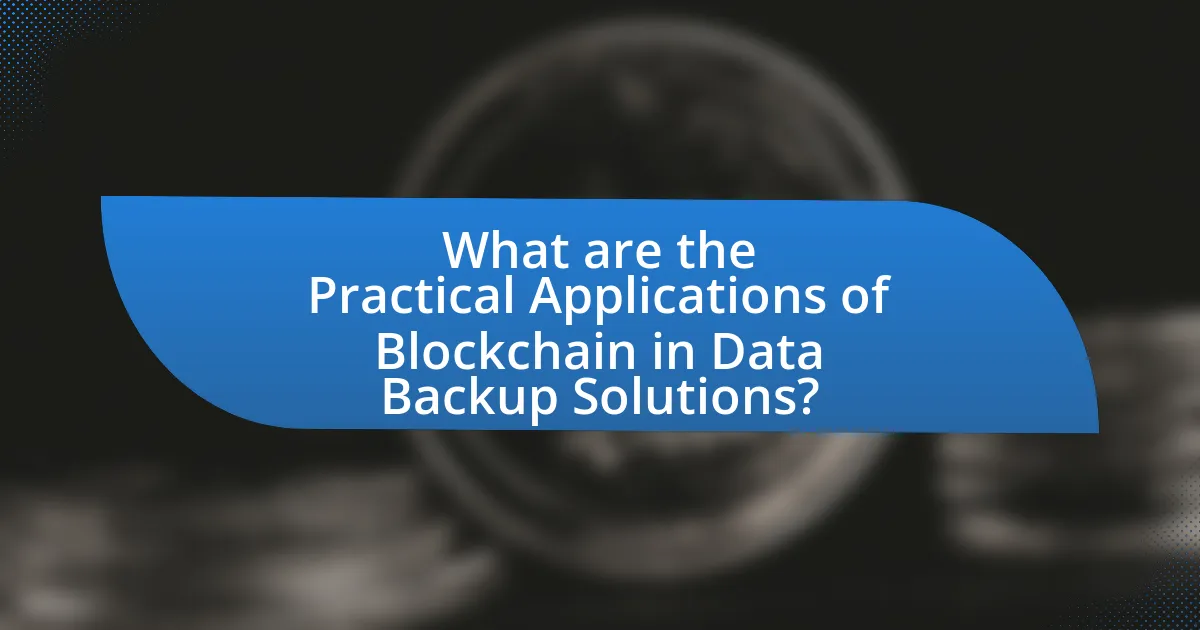Blockchain technology is a decentralized digital ledger that enhances data backup solutions by providing secure, tamper-proof storage and verification of data. This article explores how blockchain functions in data storage, highlighting its key components such as decentralization, immutability, and encryption, which collectively improve data integrity and security. It also examines the limitations of traditional data backup methods, the practical applications of blockchain across various industries, and the challenges organizations face when implementing blockchain solutions. Additionally, best practices for utilizing blockchain in data backup are discussed, emphasizing strategies to ensure a smooth transition and enhance security.

What is Blockchain Technology and How Does it Relate to Data Backup Solutions?
Blockchain technology is a decentralized digital ledger that securely records transactions across multiple computers, ensuring that the data cannot be altered retroactively without the consensus of the network. This technology relates to data backup solutions by providing a tamper-proof method for storing and verifying data, which enhances data integrity and security. For instance, using blockchain for data backups allows organizations to create immutable records of their data, making it easier to recover from data loss or corruption. Additionally, the distributed nature of blockchain reduces the risk of a single point of failure, as copies of the data are stored across various nodes in the network, ensuring availability and resilience against attacks or system failures.
How does blockchain technology function in the context of data storage?
Blockchain technology functions in data storage by creating a decentralized and immutable ledger that securely records transactions across multiple nodes. Each block in the chain contains a list of transactions, a timestamp, and a cryptographic hash of the previous block, ensuring data integrity and preventing tampering. This structure allows for transparent and verifiable data storage, as all participants in the network can access the same information without relying on a central authority. The decentralized nature of blockchain enhances security, as data is distributed across numerous locations, reducing the risk of data loss or corruption. Additionally, the use of cryptographic techniques ensures that only authorized users can access or modify the data, further safeguarding sensitive information.
What are the key components of blockchain technology that enhance data backup?
The key components of blockchain technology that enhance data backup include decentralization, immutability, and encryption. Decentralization ensures that data is stored across multiple nodes, reducing the risk of data loss due to a single point of failure. Immutability guarantees that once data is recorded on the blockchain, it cannot be altered or deleted, providing a reliable historical record. Encryption secures data by making it accessible only to authorized users, protecting it from unauthorized access and breaches. These components collectively create a robust framework for secure and reliable data backup solutions.
How does decentralization in blockchain improve data security?
Decentralization in blockchain improves data security by distributing data across multiple nodes rather than storing it in a single location. This distribution reduces the risk of data breaches, as there is no central point of failure that can be targeted by attackers. For instance, in a traditional centralized database, a successful attack can compromise all data, while in a decentralized system, an attacker would need to breach multiple nodes to access the complete dataset. Additionally, blockchain employs cryptographic techniques to secure data, ensuring that any alterations are easily detectable. This combination of distribution and cryptography significantly enhances the integrity and confidentiality of the data stored on the blockchain.
What are the limitations of traditional data backup solutions?
Traditional data backup solutions have several limitations, including vulnerability to data loss, high costs, and inefficiencies in data retrieval. These solutions often rely on physical storage devices, which can fail or be damaged, leading to potential data loss. Additionally, traditional backups can be expensive due to the costs associated with hardware, maintenance, and storage space. Furthermore, the process of restoring data from traditional backups can be time-consuming and complex, resulting in extended downtime for businesses. According to a study by the Ponemon Institute, 60% of organizations experience data loss due to backup failures, highlighting the inadequacy of these solutions in ensuring data integrity and availability.
How do traditional methods fail to ensure data integrity?
Traditional methods fail to ensure data integrity primarily due to their reliance on centralized systems, which are vulnerable to single points of failure and unauthorized access. Centralized databases can be manipulated or corrupted by insiders or external attacks, leading to data loss or inaccuracies. For instance, a study by the Ponemon Institute found that 60% of data breaches are caused by internal actors, highlighting the risks associated with traditional data management. Additionally, traditional methods often lack robust auditing and verification processes, making it difficult to detect and rectify errors or tampering in real-time. This lack of transparency and accountability further compromises data integrity, as users cannot easily verify the authenticity of the information stored.
What risks are associated with centralized data storage?
Centralized data storage poses several risks, including data breaches, single points of failure, and loss of control over data. Data breaches can occur when a centralized system is compromised, exposing sensitive information to unauthorized access; for instance, the 2017 Equifax breach affected 147 million individuals. Single points of failure mean that if the central server goes down, all data becomes inaccessible, which can disrupt operations significantly. Additionally, organizations may lose control over their data due to reliance on third-party providers, leading to potential misuse or mishandling of information. These risks highlight the vulnerabilities inherent in centralized systems, making alternatives like blockchain technology increasingly appealing for secure data management.

How is Blockchain Technology Transforming Data Backup Solutions?
Blockchain technology is transforming data backup solutions by providing decentralized, immutable, and secure storage options. This technology ensures that data is not only backed up across multiple nodes but also protected against unauthorized alterations, as each block in the chain is cryptographically linked to the previous one. For instance, a study by IBM highlights that blockchain can enhance data integrity and availability, reducing the risk of data loss due to system failures or cyberattacks. Additionally, the use of smart contracts within blockchain systems automates backup processes, ensuring timely and efficient data management. This shift towards blockchain-based solutions represents a significant advancement in how organizations approach data backup, emphasizing security and reliability.
What advantages does blockchain offer over traditional data backup methods?
Blockchain offers enhanced security, transparency, and decentralization compared to traditional data backup methods. The decentralized nature of blockchain means that data is stored across multiple nodes, reducing the risk of a single point of failure and making it more resilient to attacks or data loss. Additionally, blockchain employs cryptographic techniques to secure data, ensuring that it remains tamper-proof and verifiable. For instance, a study by the World Economic Forum highlights that blockchain can significantly reduce the risk of data breaches, which are prevalent in centralized systems. Furthermore, the transparency of blockchain allows for real-time auditing and tracking of data changes, providing an immutable record that traditional backup methods cannot offer.
How does blockchain enhance data accessibility and retrieval?
Blockchain enhances data accessibility and retrieval by providing a decentralized and immutable ledger that allows multiple users to access and verify data in real-time. This technology eliminates the need for a central authority, ensuring that data is available to all authorized participants simultaneously, which significantly reduces retrieval times. For instance, in supply chain management, blockchain enables all stakeholders to access the same data regarding product status and location, improving transparency and efficiency. Additionally, the use of cryptographic techniques ensures data integrity, allowing users to trust the information retrieved from the blockchain without the risk of tampering.
What role does encryption play in blockchain-based data backup?
Encryption is crucial in blockchain-based data backup as it ensures the confidentiality and integrity of the stored data. By encrypting data before it is added to the blockchain, unauthorized access is prevented, safeguarding sensitive information from potential breaches. Furthermore, the use of cryptographic hashing in blockchain technology guarantees that any alteration of the data can be easily detected, thus maintaining data integrity. This dual role of encryption not only protects data but also enhances trust in the backup process, as users can verify that their data remains unchanged and secure over time.
How does blockchain technology ensure data redundancy and reliability?
Blockchain technology ensures data redundancy and reliability through its decentralized structure and consensus mechanisms. Each block in a blockchain contains a cryptographic hash of the previous block, creating a secure and immutable chain of data. This design means that data is replicated across multiple nodes in the network, ensuring that even if one node fails, the data remains accessible from other nodes. Additionally, the consensus protocols, such as Proof of Work or Proof of Stake, require agreement among participants before any data can be added or altered, further enhancing reliability. This redundancy is critical in preventing data loss and ensuring that the information remains consistent and trustworthy across the entire network.
What mechanisms are in place to prevent data loss in blockchain systems?
Blockchain systems employ several mechanisms to prevent data loss, including decentralization, redundancy, and cryptographic security. Decentralization ensures that data is distributed across multiple nodes, reducing the risk of a single point of failure. Redundancy is achieved through the replication of data across the network, where each node maintains a copy of the entire blockchain, allowing recovery even if some nodes fail. Cryptographic security protects data integrity and authenticity, as each block is linked to the previous one using cryptographic hashes, making it nearly impossible to alter data without detection. These mechanisms collectively enhance the resilience of blockchain systems against data loss.
How does consensus among nodes contribute to data reliability?
Consensus among nodes enhances data reliability by ensuring that all participants in a network agree on the validity of transactions before they are recorded. This agreement process, often achieved through mechanisms like Proof of Work or Proof of Stake, prevents discrepancies and unauthorized changes to the data. For instance, in a blockchain network, if a majority of nodes validate a transaction, it becomes part of the immutable ledger, making it resistant to tampering. This collective verification process significantly reduces the risk of data corruption and fraud, thereby reinforcing the integrity and reliability of the stored information.

What are the Practical Applications of Blockchain in Data Backup Solutions?
Blockchain technology offers practical applications in data backup solutions by providing decentralized storage, enhanced security, and immutable records. Decentralized storage allows data to be distributed across multiple nodes, reducing the risk of data loss due to a single point of failure. Enhanced security is achieved through cryptographic techniques that protect data integrity and confidentiality, making unauthorized access extremely difficult. Immutable records ensure that once data is stored on the blockchain, it cannot be altered or deleted, providing a reliable audit trail for data recovery. These features collectively improve the resilience and reliability of data backup systems, as evidenced by implementations in industries such as finance and healthcare, where data integrity is critical.
Which industries are adopting blockchain for data backup solutions?
The industries adopting blockchain for data backup solutions include finance, healthcare, supply chain management, and government. In finance, blockchain enhances security and transparency in transaction records, as evidenced by the adoption of distributed ledger technology by major banks for secure data storage. Healthcare utilizes blockchain to securely store patient records, ensuring data integrity and compliance with regulations like HIPAA. Supply chain management benefits from blockchain by providing immutable records of product provenance, which helps in tracking and verifying the authenticity of goods. Government agencies are exploring blockchain for secure public records management, improving transparency and reducing fraud. These industries leverage blockchain’s decentralized nature to enhance data security and reliability in their backup solutions.
How is healthcare leveraging blockchain for secure patient data storage?
Healthcare is leveraging blockchain technology to secure patient data storage by creating decentralized and immutable ledgers that enhance data integrity and privacy. This technology allows healthcare providers to store patient records in a way that prevents unauthorized access and ensures that data cannot be altered without consensus from all parties involved. For instance, a study published in the Journal of Medical Internet Research highlights that blockchain can provide a secure framework for sharing electronic health records, reducing the risk of data breaches, which have affected millions of patients in recent years. By utilizing cryptographic techniques, blockchain ensures that only authorized individuals can access sensitive patient information, thereby fostering trust and compliance with regulations such as HIPAA.
What examples exist of blockchain use in financial data backup?
Blockchain technology is utilized in financial data backup through platforms like Everledger and Guardtime. Everledger employs blockchain to create a secure, immutable ledger for tracking the provenance of assets, particularly in the diamond industry, ensuring that financial data related to these assets is backed up and verifiable. Guardtime, on the other hand, uses blockchain to provide a tamper-proof backup solution for data integrity in various sectors, including finance, by ensuring that all transactions and data changes are recorded in a secure manner. These examples demonstrate how blockchain enhances the reliability and security of financial data backup processes.
What challenges do organizations face when implementing blockchain for data backup?
Organizations face several challenges when implementing blockchain for data backup, including scalability, integration with existing systems, and regulatory compliance. Scalability issues arise because blockchain networks can become congested, leading to slower transaction times and increased costs as data volume grows. Integration challenges occur as organizations must adapt their current infrastructure to accommodate blockchain technology, which can require significant technical expertise and resources. Additionally, regulatory compliance poses a challenge, as organizations must navigate varying legal frameworks and data protection laws that govern the use of blockchain, particularly concerning data privacy and security. These challenges can hinder the effective adoption of blockchain for data backup solutions.
How can scalability issues impact the effectiveness of blockchain solutions?
Scalability issues can significantly hinder the effectiveness of blockchain solutions by limiting transaction throughput and increasing latency. When a blockchain network cannot efficiently handle a growing number of transactions, it leads to slower processing times and higher fees, which can deter users and businesses from adopting the technology. For instance, Bitcoin’s network has faced congestion during peak usage times, resulting in transaction delays and fees that soared to over $50 in 2017. This inefficiency undermines the core promise of blockchain technology, which is to provide a fast, secure, and cost-effective alternative to traditional systems. Therefore, without addressing scalability, blockchain solutions may struggle to meet the demands of widespread use, particularly in data backup applications where speed and reliability are crucial.
What regulatory considerations must be addressed when using blockchain for data backup?
When using blockchain for data backup, regulatory considerations include compliance with data protection laws, such as the General Data Protection Regulation (GDPR) in Europe, which mandates that personal data must be processed lawfully and transparently. Additionally, organizations must ensure that they adhere to industry-specific regulations, such as the Health Insurance Portability and Accountability Act (HIPAA) for healthcare data, which requires strict controls over the handling of sensitive information. Furthermore, the immutability of blockchain can conflict with the right to erasure under GDPR, necessitating careful planning to ensure compliance. These regulations highlight the importance of understanding legal frameworks and implementing appropriate measures to safeguard data while utilizing blockchain technology for backup solutions.
What are the best practices for utilizing blockchain technology in data backup?
The best practices for utilizing blockchain technology in data backup include ensuring data integrity, implementing decentralized storage, and utilizing smart contracts for automated processes. Data integrity is maintained through cryptographic hashing, which secures data against tampering; this is evidenced by the immutability feature of blockchain, where once data is recorded, it cannot be altered without consensus from the network. Decentralized storage distributes data across multiple nodes, reducing the risk of data loss due to a single point of failure, as demonstrated by platforms like Filecoin and Storj. Additionally, smart contracts can automate backup processes, ensuring timely and consistent data backups without human intervention, which enhances reliability and efficiency. These practices collectively leverage blockchain’s strengths to create a robust data backup solution.
How can organizations ensure a smooth transition to blockchain-based backup solutions?
Organizations can ensure a smooth transition to blockchain-based backup solutions by implementing a phased approach that includes thorough training, pilot testing, and integration with existing systems. This method allows organizations to gradually adapt to the new technology while minimizing disruptions. For instance, conducting pilot projects can help identify potential challenges and refine processes before full-scale implementation. Additionally, providing comprehensive training for staff ensures that employees are equipped to utilize the new system effectively. Research indicates that organizations that adopt a structured transition plan experience a 30% reduction in implementation time and a 25% increase in user satisfaction, demonstrating the effectiveness of this approach.
What strategies can enhance the security of blockchain data backups?
Implementing multi-signature wallets significantly enhances the security of blockchain data backups by requiring multiple private keys to authorize a transaction. This strategy mitigates the risk of unauthorized access, as a single compromised key is insufficient for data retrieval. Additionally, utilizing decentralized storage solutions, such as IPFS (InterPlanetary File System), ensures that data is distributed across multiple nodes, reducing the likelihood of data loss or tampering. According to a study by the University of Cambridge, decentralized systems provide greater resilience against attacks compared to centralized counterparts, reinforcing the effectiveness of these strategies in securing blockchain data backups.


